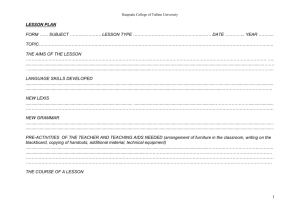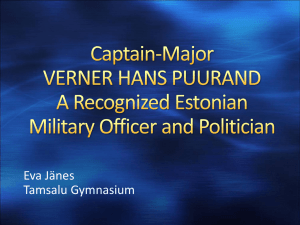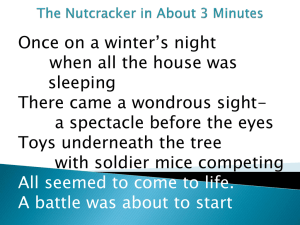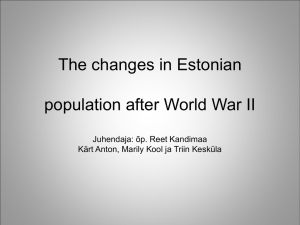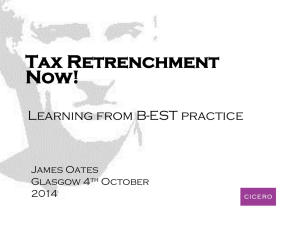rituals
advertisement
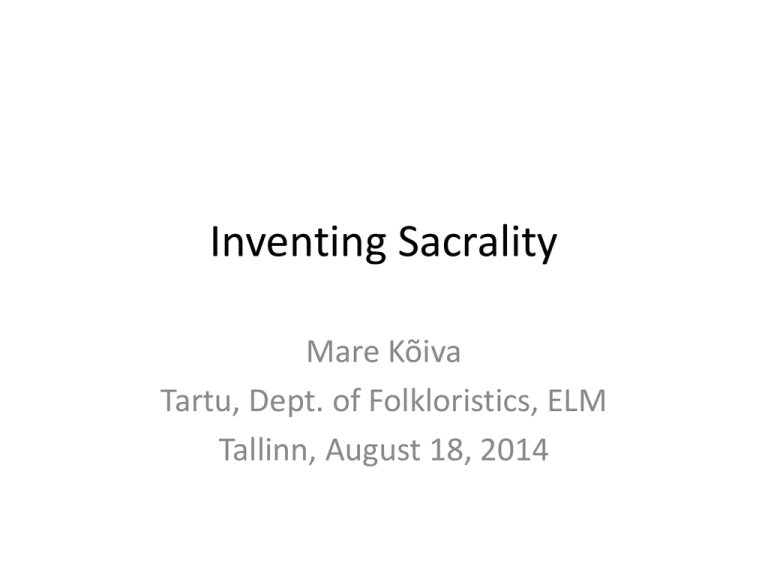
Inventing Sacrality Mare Kõiva Tartu, Dept. of Folkloristics, ELM Tallinn, August 18, 2014 I am honored to greet Arvo Krikmann, a friend and colleague, all the folklorists and members of the academy of sciences and academicians. The present paper is inspired by hobby Arvo Krikmann had for years and the notes he took in the course. Namely, it used to be that he took his wife, a very wise woman, for long walks in Tartu. These walks gave rise to summarized reports of the changes and life in the city of Tartu which he shared with his colleagues at Vanemuise Street 42. There was a period when Kriku and Luule counted all dogs and cats they encountered and Arvo used that number to calculate an estimate of how many dogs lived in Tartu. The number was enormous, frighteningly so. But was well in accordance with West European city statistics. However, the trip I would like you to accompany to today is not related to dogs. Instead, it is based on different monuments. What about? This paper introduces and compares contemporary sacred places: A short characterisation is given of: 1)Variety of culturally valued places 2)Variety of sacred places The aim of the paper is to reevaluate and deconstruct these places using Hobsbawm and Ranger’s concept of invented tradition (1983), studies of new religiousity/spirituality (York 2001, etc.), and concepts about the place and space. There are several terms connected with new spirituality (ethnic, or pagan, or neopagan) as religion – it encompasses several recognised and coherent sets of beliefs and practices (e.g. Harvey 1997; Greenwood 2000; York 2001, Blain 2002; Wallis 2003, etc.). It comprises a variety of traditions which can be seen academically as sets of discourses and practices giving adherents standpoints from which to engage with the natural and social worlds, ritual practices, concepts with which to develop these engagements. In many countries in Europe ethnic religiosity or paganism started to develop at the beginning of the 20th century. In the Estonian case, religious movements called Maa usk (Earth believers, 1990ies) or also Taara-usk (Taara-belief) complete with rituals, ritual objects and sacred groves emerged in the 1920s. In Estonia some of these monuments are unexptected or even indecent, like the monument dedicated to Schiller in Puhtu. We can see it as a mixture of creativity, sacrality and/or mythologisation, cultural inventions. A good example of the latter were the home-made fly agaric or fly mushrooms one could see in Soviet Tartu. In order to make one, you had to take a washing basin, turn it upside down, paint red and add white spots. The current discourse of erecting wooden sculptures has added significance to various historical locations (Varbola fort-hill, Kassinurme). Beginning of 20th century: many teachings: Ethnic religion Buddism, Esoteric branches (Blavatskaya, Keyserling, etc.,) in 1980ies Castaneda – experiments with the state of mind, during Soviet time visits to Siberia, Buryat area; 1990ies and later : trips to China, India: Chinese teachers; teachers with different background and nationalities, American Indian leaders, New Age, spiritual leaders, Permaculture / smart house- movement Roman Espenberg – Haavamäe . At the other end of the same continuum is the peculiar cultural invention seen in Haapsalu – a bench dedicated to Chaikovsky and statues erected in the city public space. Behind these we find one city architect whose creative powers took an interesting form. Roman Espenberg-Haavamägi started his studies in Tallinn under the hand of Nikolai Triik. Although he had a promising start, he did not receive a higher diploma in art. However, he studied on his own and managed to leave a mark on the Estonian cultural landscape. In 1923, two painted wooden sculptures erected at African beach (Polar Bear and Sea Lion). In 1931-32 he completed coloured figures Mickey Mouse, Maraboo, Elfs and the stairs on both sides of the Social Hall (Kuursaal) in Haapsalu. The latter the sculptor hewed out at Holmi Street 5, where the parent of Ella Kingo lived. Sometimes, he erected his monuments on purpose in sites that needed a caring hand. For example, the monument to E. Enno and Chaikovsky’s bench were erected on the sites of former garbage dumps. His art made Haapsau special prior to the world wars. The re-use of traditional means, invention of new elements , importance of creator, masters of rituals, Individually developed rituals: and rituals for balancing the personality, and other situations. Innovations have been made in the place, ritual dress code, and items used in rituals. Rituals dedicated to mythology, dedicated to supernatuaral powers. Re-use of old cultic places, archeologiacal places. F Sass of Vigala 1990 Thule Lee 1999 Creating Locations, According to certain Models An old location with famous past, a natural site – balanced relations with nature, cultural identity are what establish locations, places of power. 1.Sacred sites located on privately owned land, used for conducting rituals. Usually they are surrounded by large stones, stone circles and labyrinths, wooden teepees (traditional “summer kitchen”). Dedicated cult sites are often surrounded with something, the space is marked as separate from nearby economic, industrial, forestry and entertainment regions. Sometimes an inner circle is constructed in addition to the outer. Usually, an entrance gateway is marked, often with an additional sounding board or other soundyielding decorated wooden objects with something to strike it with. Objects borrowed from various cultures – crosses and runes – Estonian landscape´and wirting, added Scandinavian style. Copy of Stonehenge, the straw figures from old Estonian folklore (found also elsewhere in Europe). Wooden figures of Estonian and etc. gods and guardian spirits. Both trees originally growing at the site have been used (one became a sacrificial tree) and new ones planted purposefully. Merle and the ritual Woods Crone (Irje Karjus, born 1968, with higher philological education in folklore) on the 23rd of June 2011 where also spells were used. A 43-year-old woman with higher education and mother of three lives in a forest farm that is hard to access. She is one of the leaders of the local farm movement. She founded the Woods Crone family park and she has become active in organising the camps and moves forward to plant healing and being a medium. Moreover she has published a series of popular books. Her knowledge about the nature were obtained when she moved from the town to a farm in southern Estonia in the middle of the nature. Yet she obtained some knowledge from books. There may be also a unique house or edifice where most rites are performed while sanative figures surround it. 2. Sites created in public locations (state-owned forest, village communal grounds) may be of similar structure as the above. Sometimes the site is not circumscribed being in an out-of-theway location that an outsider is unlikely to visit. As a rule, a large stone, tree or water body is a central feature; some places display an incantation or prayer/plea/supplication to be read at that site. Some places are furnished with a list of behavioural rules. Small sacrifices (coins, fruit, strips of cloth, etc.) are placed usually on a stone. Vastseliina 2. Sites created in public locations (state-owned forest, village communal grounds) may be of similar structure as the above. Sometimes the site is not circumscribed being in an out-of-theway location that an outsider is unlikely to visit. As a rule, a large stone, tree or water body is a central feature; some places display an incantation or prayer/plea/supplication to be read at that site. Some places are furnished with a list of behavioural rules. Small sacrifices (coins, fruit, strips of cloth, etc.) are placed usually on a stone. a. Parks or trails in picturesque public locations (for example, the Great and Small power trail in Elva, Estonia) features wooden figures with various connotations (folklore, old gods, just figures) among living trees from which one can draw health, strength, balance, etc. b. Wooden pillars of energy, since the 1990s, consecrated with initiation rite as places of special power. For example, large wooden pillars in Otepää, Estonia or in teh karst area closer to Tallinn. Wooden Gods ELVA 2007 Place for rituals End of the journey. Contact with trees and water power Power path 2.c. Wooden god figures – they have no roots in the Estonian cultural space (excl. Schulktz Bertrams garden, etc.), a new movement that emerged in recent decades inspired by sculptors’ work; the ideas originate from Estonian and Finno-Ugric mythologies, Estonian pseudomythology (so-called ancient gods created by fiction writers). Found in many places, some created for purposes other than worship, used by multiple groups. 3. 3. Archaeological sites – archaeological objects under protection, old burial and settlement sites. Single big sacrificial stones or fields of so-called small-cupped stones (common in northern Estonia, large sacrificial stones that are widespread in western Estonia and the islands), fields thousands of years old and other cultural landmarks, city fort hills and fortifications from the 13th century. 4. Natural objects under protection – trees or other unique wilderness preserves as well as just deep forests, marshes, etc. places that bring one close to nature. 5. Monuments that have historical or cultural significance and where religious rituals are conducted (more usually as an integrated part of wedding, student initiation or other customs). This includes monuments dedicated to culturally significant persons and mythology. 6. A piece of nature in the city (for example, Skone Bastion in Tallinn, Estonia), lake- or riverside, a forest grove, city part or other green spot with no distinguishing features. Dwarfland 2007 Mushrooms land - 2013 Today, this has morphed into series of dedicated benches: some dedicated by the local community to people they find significant (in the yard of Toila-Oru High School, a bench dedicated to the school director), the rich dedicate to their favourites (a bench on Sõrve peninsula dedicated to Vestmann), media people to their stars (a bench dedicated to folk healer Kaika Laine, from TV show host Vahur Kersna). This mythologised cultural history is also refected in the newest generation of Haapsalu benches – benches dedicated to winners of the Wiedemann language award, and the first folklorist to be nominated was Arvo Krikmann in 2014. Euro Bench Conclusions Places or spaces are polyfunctional, used by diffent groups at different times. They are connected with different valkues. It is not uncommon to observe several communities operating at the same time and same space side by side. They use the same space, but for different purposes; they have different demands of the location as well as dissimilar motivation for using that site. For example, in Tallinn, Estonia, next to the Skone Bastion there was an incantation performed, dedicated to the Earth Mother. In the same neighbourhood moved and acted several social groups that had no connection whatsoever with the neoshaman and members of various neoreligious movements. More than 60 nebches – IN Haapsalu. ONE OF THEM DEDIcated to Arvo Krikmann.
